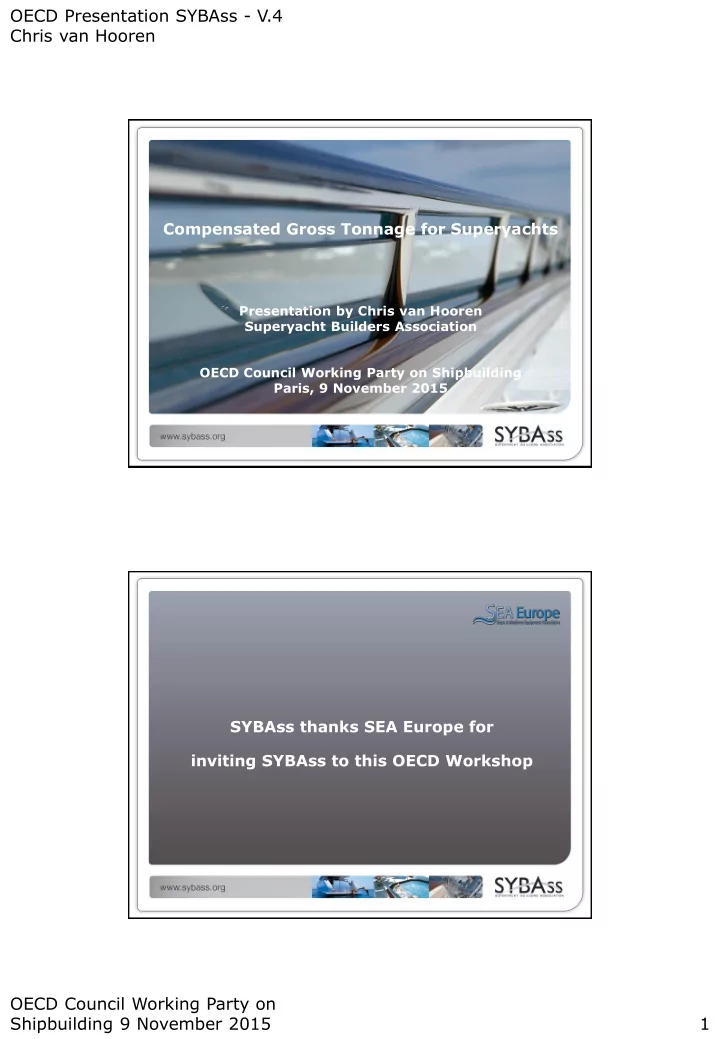

OECD Presentation SYBAss - V.4 Chris van Hooren Compensated Gross Tonnage for Superyachts Presentation by Chris van Hooren Superyacht Builders Association OECD Council Working Party on Shipbuilding Paris, 9 November 2015 SYBAss thanks SEA Europe for inviting SYBAss to this OECD Workshop OECD Council Working Party on Shipbuilding 9 November 2015 1
OECD Presentation SYBAss - V.4 Chris van Hooren Content • Who is SYBAss and what are Superyachts; • Growth of Superyacht Fleet; • Typical Cost levels; • Is CGT needed for Superyachts? • Concept of Compensated Gross Tonnage (CGT); • Method for determining CGT for Superyachts; • Results of CGT determination for Superyachts; • CGT Ranking of Superyacht Sector worldwide; • Conclusion. Superyacht Builders Association SYBAss represents 23 superyacht builders worldwide (motor and sail) Over the last 10 years their market share is about 50% of all superyachts OECD Council Working Party on Shipbuilding 9 November 2015 2
OECD Presentation SYBAss - V.4 Chris van Hooren Superyachts Growth of Superyacht fleet (Courtesy Boat International Media) Number/year GT/year Over 50% of Superyacht fleet is built between 2000-2010 OECD Council Working Party on Shipbuilding 9 November 2015 3
OECD Presentation SYBAss - V.4 Chris van Hooren Typical Distribution Building Cost GT-ratio ~ 1:30 Superyacht Ropax Ferry Cost ratio ± 50% cost related to ± 50% cost related to ~ 1:2 Hull + Accomodation Hull + Hull Outfit Economic importance of Superyachts Is economic importance recognised considering Superyacht’s: Major growth since year 2000 ? High Cost/GT ratio ? This presentation will provide insight into this question OECD Council Working Party on Shipbuilding 9 November 2015 4
OECD Presentation SYBAss - V.4 Chris van Hooren How to assess economic importance? The CGT-concept is generally used to answer this question; For Superyachts often existing CGT-coefficients are used, for example of Passenger Ships, Ferries or NCCV; Does such approximation result in a proper assessment of the current economic importance of the Superyachts? GT-ratios compared to Cost-ratios make this doubtfull; Delft University of Technology in The Netherlands (DUT) has determined CGT-coefficients for Superyachts. What is CGT? GT: “Gross Tonnage” Measure of the enclosed volume of a vessel CGT: “Compensated Gross Tonnage” Accounts for the complexity/workload of certain ship type and size C-Factor: C-factor CGT / GT “Complex” ship type “Simple” ship type GT OECD Council Working Party on Shipbuilding 9 November 2015 5
OECD Presentation SYBAss - V.4 Chris van Hooren 2007: CGT=A*GT^B A and B referred to as ‘CGT - coefficients’ CGT study for Superyachts • OECD does not provide methodology for determining CGT; • Therefore DUT developped a specific approach to CGT; • Available data: – For 18 Control Vessels ; – For 36 Superyachts. OECD Council Working Party on Shipbuilding 9 November 2015 6
OECD Presentation SYBAss - V.4 Chris van Hooren Approach Delft University Total Production Effort: Effort Yard + Effort External Effort External: Effort Suppliers + Subcontractors Assumptions CGT is based on Total Production Effort; External Costs are fair indicators for associated efforts; Profit margin of Yard is proxy for External profit margin; Ratio labour/materials cost same for Yard and External. (for disciplines shared by Yard and External) Method is validated against 18 Control Vessels DUT study CGT - Observations 1. The DUT Method gives good results for the Control Group; 2. It is not realistic to use for Superyachts CGT-coefficients for Passenger Ships, Ferries or NCCV ; 3. Specific CGT-coefficients for Superyachts are justified. For details of the DUT study CGT refer to: Determination of the Compensated Gross Tonnage factors for Superyachts Jeroen F .J. Pruyn et al, International Shipbuilding Progress 57 (2010) or: http://www.sybass.org/fields-of-interest/professionalism OECD Council Working Party on Shipbuilding 9 November 2015 7
OECD Presentation SYBAss - V.4 Chris van Hooren DUT study CGT - Result 95% confidence area CGT superyachts CGT=A*GT^B For Superyachts: A = 278 and B = 0.58 Ranking of Superyacht Industry Based on GT Based on CGT for Superyachts Source: Economic impact of the Superyacht Industry worldwide Frank Bruinsma & Thomas de Graaf – Amsterdam Free University OECD Council Working Party on Shipbuilding 9 November 2015 8
OECD Presentation SYBAss - V.4 Chris van Hooren In Conclusion: SYBAss invites the OECD to consider: CGT=A*GT^B: For Superyachts A = 278 and B = 0.58 Thank you OECD Council Working Party on Shipbuilding 9 November 2015 9
Recommend
More recommend